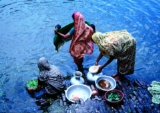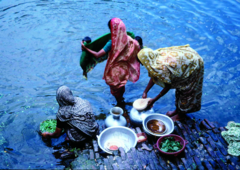
Cloth filter
Encyclopedia

Bangladesh
Bangladesh , officially the People's Republic of Bangladesh is a sovereign state located in South Asia. It is bordered by India on all sides except for a small border with Burma to the far southeast and by the Bay of Bengal to the south...
, the cloth filter is a simple and cost-effective appropriate technology
Appropriate technology
Appropriate technology is an ideological movement originally articulated as "intermediate technology" by the economist Dr...
method for reducing the contamination of drinking water. Water collected in this way has a greatly reduced pathogen
Pathogen
A pathogen gignomai "I give birth to") or infectious agent — colloquially, a germ — is a microbe or microorganism such as a virus, bacterium, prion, or fungus that causes disease in its animal or plant host...
count - though it will not necessarily be perfectly safe, it is an improvement for poor people with limited options.
Method
The method used in Bangladesh is as follows: an old sariSari
A sari or sareeThe name of the garment in various regional languages include: , , , , , , , , , , , , , is a strip of unstitched cloth, worn by females, ranging from four to nine metres in length that is draped over the body in various styles. It is popular in India, Bangladesh, Nepal,...
is folded to make four or eight layers. The folded cloth is placed over a wide-mouthed container used to collect surface water.
It is usually sufficient to rinse the cloth and dry it in the sun for a couple of hours. In the monsoon
Monsoon
Monsoon is traditionally defined as a seasonal reversing wind accompanied by corresponding changes in precipitation, but is now used to describe seasonal changes in atmospheric circulation and precipitation associated with the asymmetric heating of land and sea...
seasons, it may be advisable to use a cheap disinfectant to decontaminate the material.
The preferred cloth is used cotton sari cloth. Other types of clean, used cloth can be used with some effect, though the effectiveness will vary significantly. Used cloth is more effective than new cloth, as the repeated washing reduces the space between the fibres.
Effectiveness
The cloth is effective because most pathogens are attached to particles and plankton, particularly a type of zooplankton called copepodCopepod
Copepods are a group of small crustaceans found in the sea and nearly every freshwater habitat. Some species are planktonic , some are benthic , and some continental species may live in limno-terrestrial habitats and other wet terrestrial places, such as swamps, under leaf fall in wet forests,...
s, within the water. By passing the water through an effective filter, most cholera bacteria and other pathogens are removed. It has been demonstrated to greatly reduce cholera
Cholera
Cholera is an infection of the small intestine that is caused by the bacterium Vibrio cholerae. The main symptoms are profuse watery diarrhea and vomiting. Transmission occurs primarily by drinking or eating water or food that has been contaminated by the diarrhea of an infected person or the feces...
infections in poor villages where disinfectants and fuel for boiling are difficult to get.
In sub-Saharan Africa
Sub-Saharan Africa
Sub-Saharan Africa as a geographical term refers to the area of the African continent which lies south of the Sahara. A political definition of Sub-Saharan Africa, instead, covers all African countries which are fully or partially located south of the Sahara...
where guinea worm dracunculiasis infections are endemic, infection is prevented by use of a nylon mesh with pore size of approximately 150 μm to filter out the copepods that host the parasite.
An old cotton sari, folded, creates a smaller effective mesh size (approximately 20-μm). This should be small enough to remove all zooplankton, most phytoplankton, and thus a large proportion of the cholera in the water (99%, according to laboratory studies). However, the nylon net with the larger mesh size was found to be "almost equally effective."
The cloth filter provides less than ideal purification on its own - usually filtering is an initial step, to be followed by further disinfection. However, where there are no other options, water professionals may consider that it is "of course, better than nothing"
Background
The cloth filter has been studied and reported on by Rita ColwellRita R. Colwell
Rita R. Colwell is an environmental microbiologist and scientific administrator. She became the 11th Director of the United States National Science Foundation on August 4, 1998....
and Anwar Huq from the University of Maryland Biotechnology Institute
University of Maryland Biotechnology Institute
Formed in 1985, the University of Maryland Biotechnology Institute is part of the University System of Maryland. It was created to provide a unified focus for Maryland's biotechnology research and education.-About UMBI:...
, together with other researchers from the USA and Bangladesh
Bangladesh
Bangladesh , officially the People's Republic of Bangladesh is a sovereign state located in South Asia. It is bordered by India on all sides except for a small border with Burma to the far southeast and by the Bay of Bengal to the south...
. They report that:
- It is common practice in villages in Bangladesh to use cloth, frequently a flat, unfolded piece of an old sari, to filter home-prepared drinks.
The researchers studied the application of this technique to drinking water, with folded cloth. They studied the pore size of the cloth, the effect of folding the cloth on the effective pore size, the ability of the cloth to remove particles and plankton, as well as the effect on rates of cholera when used in a Bangladesh village.
External links
- Safe Saris - Bangladesh
- NSF Director Colwell Fights Spread of Cholera with Saris
- Sari filter stops cholera, with photo. ICDDR,B website.
- Photo showing woman using sari to filter drinking water - Source: Dr. Rita Colwellhttp://www.nsf.gov/news/speeches/colwell/rc02_hippocratic/tsld025.htm

